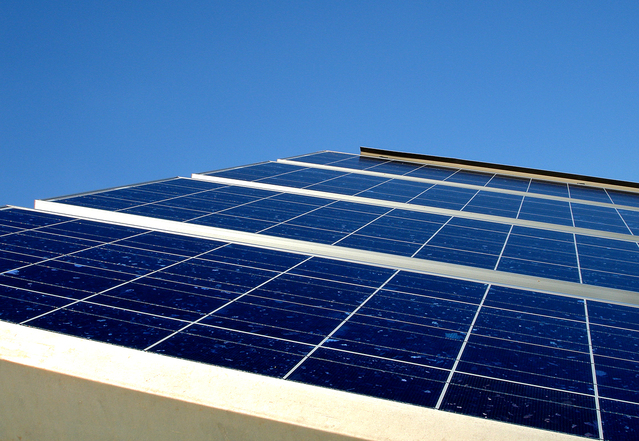http://www.dnaindia.com/analysis/column-policy-watch-solar-wobbles-ahead-2057224
Solar wobbles ahead
R N Bhaskar
First the good news. Cumulative solar installations in India crossed the 3 GW mark (100 Mega Watts or MW equals one GigaWatt). Figures compiled by the Mercom Capital Group show that almost 734 MW of solar capacity got installed during this year till November 2014.
But as the chart shows, the capacity installed in 2014 was less than what was installed in 2013. “This was a 20% drop year-over-year. Land acquisition delays due to elections and uncertainty caused by the anti-dumping case contributed to a slowdown in installations,” explains Mercom. But it forecasts installations in 2015 to more than double, reaching approximately 1,800MW.
But this is where the smiles ought to stop. There are good reasons to believe that the government’s solar policy is warped, even shortsighted.
Land grab
The government has been allocating large tracts of land for solar power generation. That could make solar power generation resemble a land-grab operation, with disastrous consequences a few decades later. It is surprising that the government has not thought of encouraging rooftop solar instead, at least in the large metros, where solar capacity could be installed, without any additional land being used up, and without long transmission lines, because the biggest consumers of solar power could be the city-dwellers themselves. The idea isn’t new. Israel began doing this since 1969, to insure itself against the energy vulnerability it faced from West Asia’s oil -rich countries. All buildings post 1969 must have rooftop solar installations.
Germany adopted this policy since the beginning of 2000 when the ‘Greens’ gained power at the centre. Hermann Scheer, minister of energy, drew up plans for promoting solar power in a manner that had never been envisaged before.
He was aware that no matter how much of subsidy solar power was to be given, it would be minuscule compared to the (largely forgotten) subsidies that the oil and gas industries have enjoyed all along as evident from the chart alongside (do watch an immensely watchable video on Scheer’s strategy.
Another indicator of the subsidy is given in a landmark paper on energy (What Would Jefferson Do? The Historical Role of Federal Subsidies in Shaping America’s Energy Future by Nancy Pfund and Ben Healey, DBL Investors, September 2011) where Pfund and Healey point out how, “In inflation-adjusted dollars, nuclear-spending averaged $3.3 billion over the first 15 years of subsidy life, and O&G subsidies averaged $1.8 billion, while renewables averaged less than $0.4 billion.”
Scheer recipe
In order to remedy such distortions, Scheer did three things. First, he allowed the government to subsidise solar power generation in an attempt to wean his country away from polluting and hazardous conventional power.
Second, he encouraged every household rooftop to be used for installing solar power panels. Households could use as much of solar power as they generated free of cost. The surplus power would be bought back by the government at reasonably attractive rates. Residents, whose rooftops were ideal for setting up such capacities, were quick to grab this offer.
By 2014, solar power in Germany (mostly through photovoltaics or PV) accounted for an estimated 6.2 to 6.9 per cent of the country’s net-electricity generation. The country has been the world’s top PV installer for several years and still leads in terms of the overall installed capacity, that amounts to 38 GW, ahead of China, Italy, Japan and the US. About 1.4 million photovoltaic systems are installed all over the country, ranging from small rooftop systems to medium, commercial and large utility-scale solar parks.
But the third measure he introduced is what made his plans work. And it has lessons for India as well, if only its policymakers pay heed. He allowed for the creation of a new category of installer-aggregators, whose job was not merely to install, but also to service and maintain the systems across the country in return for a certain share in the revenues generated. They would also aggregate the minuscule amounts of solar power generated by each household, clean it up, and sell it to the grid at pre-determined costs. These installer-aggregators would also supervise the bi-directional electricity meters. This third measure did several things for Germany.
First, it removed the hassle that householders would face in supervising the installation of solar panels, and their maintenance. All this was taken care of by the installer-aggregator. Second, it unleashed the innovation potential among the hundreds of thousands of installer-aggregators across the country, making Germany a global innovation centre for solar power. More importantly, it created jobs. According to official figures, some 3,70,000 people were employed in the renewable energy sector in 2010, especially in small and medium-sized companies. This is an increase of around 8% compared to 2009 (around 3,39,500 jobs), and well over twice the number of jobs in 2004 (1,60,500). Almost two-thirds of these jobs are attributed to the measures announced by Scheer. Today, this sector employs more people that the famed automobile industry in Germany.
Do this for India
India has limited land. And it needs to create millions of jobs. Logically, therefore, India should be aggressively promoting rooftop solar. It should also introduce policies for creating an installer-aggregator community which can interface between the power grids and the rooftop owners. That is a lesson India has not yet learnt from Germany.
The sheer absence of these two policies shows how limited the vision of the ministry of energy can be.
The author is consulting editor with DNA.
Read the original article here.
Click here for more on India and its policies.







































COMMENTS